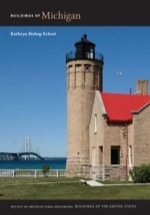
This building is a worthy successor to the congregation's earlier home on Woodward Avenue ( WN85). The plan includes a school wing skillfully done in the International Style, but it is the sanctuary that is riveting. Modeled on the biblical Tent of Meeting, the great tapering concrete frame is clad with aluminum panels whose joints emphasize the vertical thrust of the design. On the interior, windows along the base of the vault admit sunlight, provide views of the landscaping, and make the wall/ceiling appear to float as if suspended. The ark wall, an arresting interplay of gilded metal and warm wood, also draws the eye upward. The drama of the space is itself a presence, dwarfing the 1,800 worshippers even when the prayer hall is full. In the foyer is a sculpture commemorating the victims of the Holocaust; in the adjacent space is a museum of Judaica and the stained glass windows by Heinigke and Smith of New York City from the earlier temple on Woodward. Several large meeting rooms, combinable social halls, and an office wing complete the building complex by Yamasaki, who had earlier done a similar, and yet quite different, “Jewish cathedral” for a Reform temple in north suburban Chicago. A major influence on the Detroit design was Eric Mendelsohn's unexecuted design for Emanu-El in Dallas (1951).

